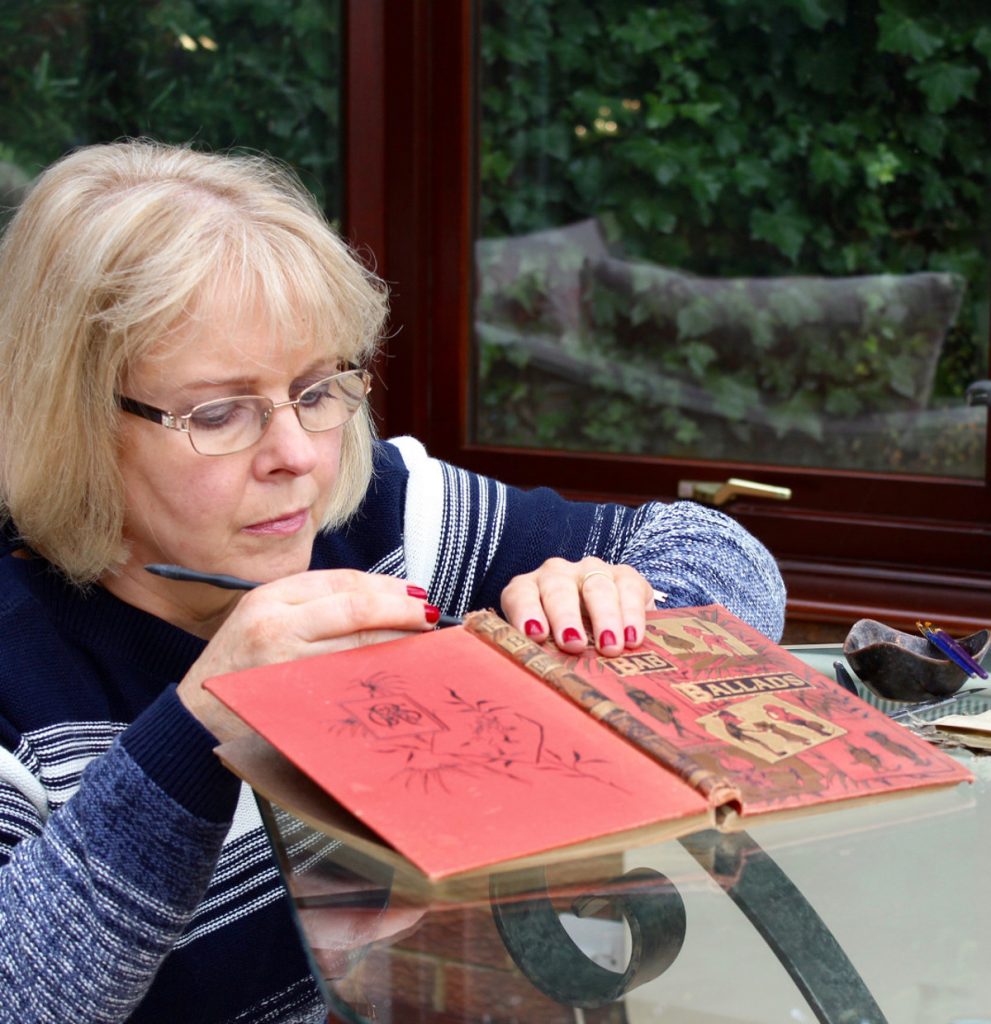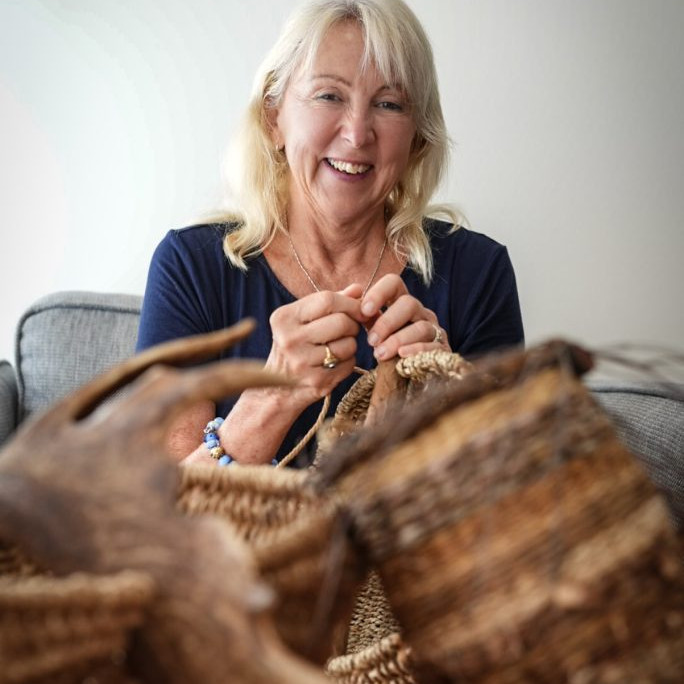Kerry Miller Book Sculptor
Can you expand on several of your floral works?
One of the first flower book sculptures I made was called “Plant Life of the Black Forest” where I made the illustrations into a circular bouquet or large posy. I framed it then placed it above the fireplace at home and was quite surprised by people’s reactions. “Oh, look you’ve used real flowers. No, hang on, they can’t possibly be real. Can they?”

Plant Life of the Black Forest, 415 x 444 x 110 mm, Mixed Medium
This spurred me on to try using flowers in different ways and forms.
With “English Botany, vol 2” there was an added challenge in making the sculpture. As a botany book, the flowers were represented with roughly half of each plant being coloured and the other half being left as a black and white line drawing. My challenge was to colour the black and white part of each illustration using watercolour, to seamlessly match the coloured part. It was a time consuming labour of love.
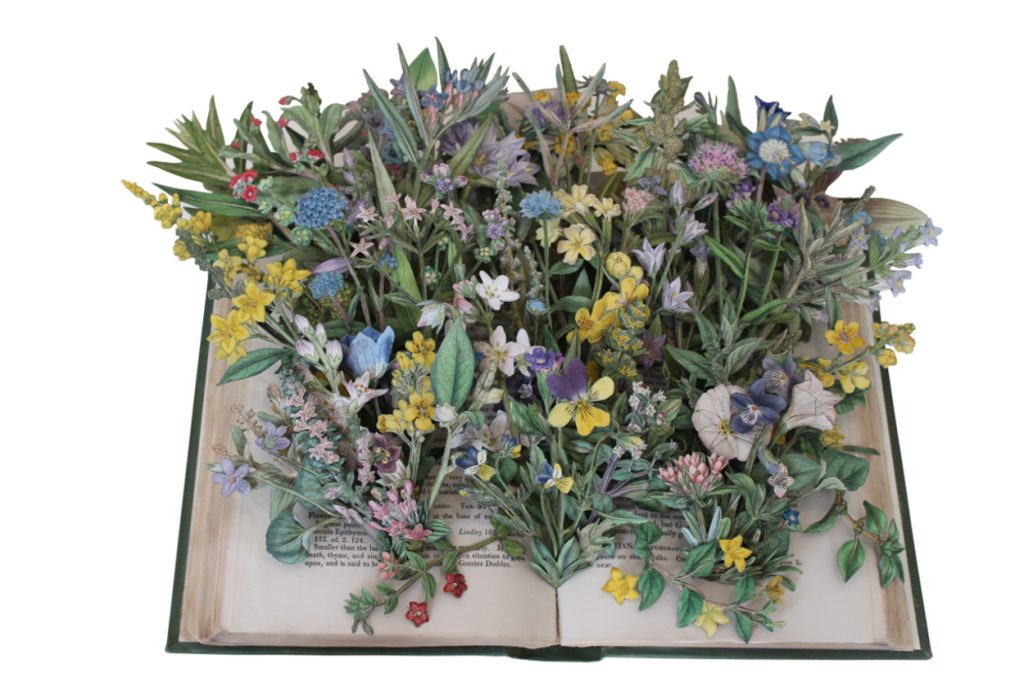
English Botany, vol 2, 150 x 232 x 36mm, Mixed Medium
“Flowering Plants of Great Britain, vols 1 and 2” also had additional challenges. The sculptures were commissioned for a cruise ship, so they needed to be able to withstand a salt atmosphere and vibrations from the ship. I enjoyed finding ways of achieving this, without affecting the character of the work.
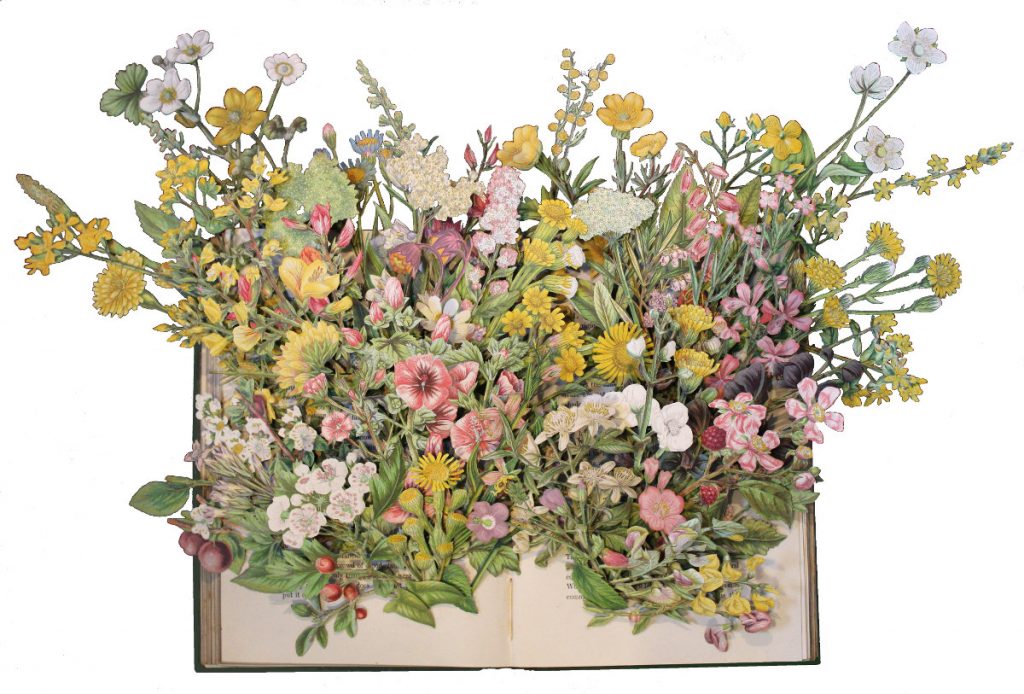
Flowering Plants of Great Britain, vols 1 and 2,approx, 330 x 520 x 90mm Mixed Medium
A few years ago I found a lovely book of butterflies and moths, which I was keen to use. The problem was that they did not have a habitat, that is there were no plants for them to rest upon. I overcame this by adding plants from two volumes of flower books. Thus “Butterflies & Moths Of The Countryside/Wild Flowers Vols 1 & 2” was born. At the time I wrote this description:
“A large butterfly book lies open on the table, two little wild flower books strewn casually across the top. As if by magic, a profusion of wild flowers springs from their pages, carpeting them in layer upon layer of green fronds and an intricate kaleidoscope of floral colour. Butterflies and moths escaping the confines of their book, now fluttering gently in amongst the flowers, alighting on their fresh and delicate petals – completing the scene of a glorious, peaceful English spring”.
Butterflies & Moths Of The Countryside/Wild Flowers Vols 1 & 2, 305 x 470 x 120mm, Mixed Medium
Where do you source your books from?
Finding a suitable book for my work is never an easy task, but it is very much an enjoyable and rewarding part of the process. I spend hours rooting around in jumble sales, charity shops, dusty old bookshops, giveaways – anywhere that has old discarded books with illustrations.
Do the books have to be full of illustrations?
Unless a book is quite heavily illustrated, I wouldn’t even consider using it. It also has to capture my imagination. The finished sculpture needs to be both richly populated with illustrations and contain a large amount of detail.
Detail makes me happy!
Are the illustrations coloured or do you colour some of them?
With one or two exceptions, all my book sculptures have had colour added by myself, even where the illustrations were coloured already. I use variously acrylics, watercolours and inks to achieve the seamless and harmonious look I want.
In the case of black and white illustrations, I find that colour adds a sense of realism and brings the characters to life.
Do you ever have critics say that you should not deface books?
People seem to realise that what I am actually trying to achieve is the re-purposing of books, giving them new life and opening them up to a wider audience.
I am quite proud of the fact that I can make use of books that others might consider to be in an unusable condition.
As friends and neighbours have become aware of my work, I have found bags of books left on my doorstep or handed to me at social events, in the hope that I can use them. Many of these books would otherwise have ended up simply being recycled.
How did you come to this art form?
I have been working in collage for more years than I care to remember.
My book sculptures were a natural progression and the result of lengthy experimentation, using books as a means of producing work in 3D. As I perfected my techniques and developed processes using this extra dimension, I was able to produce far more complex and therefore – as far as I’m concerned – more satisfying work.
“Book Sculptures”
Sketches by Boz – Kerry Miller’s sculptures from Emanuele Marani on Vimeo.
Do you use only old books?
So far, I have chosen to use only old books or those published more recently, but which contain old illustrations. I find that these lend themselves to my work in a way that perhaps modern books would not. I believe that the books I use have been lost in time and that this gives me the opportunity to reveal them to the world once more, but in a very different form.
Have any current artists commissioned you to use their book or books?
Not so far, though I am quite intrigued by the idea.
How do you decide on using the front cover or the book open?
In many ways, the book itself will dictate whether I make it as an “open” or “closed” sculpture, though the final decision is often made at a relatively late stage in the process.
The type, character and number of the illustrations can often help me to decide. Working with them, as I cut them out and take them through a series of processes, enables me to lose myself in their miniature world and, from this, my vision for the finished work gradually forms.
Discuss your use of volumes of magazines
In Victorian times, weekly or monthly magazines were periodically bound into a volume. The fun of working with such books lies in the wide variety of subjects illustrated within.
Do you see your work as that of a ‘social historian’?
No, I would not make such a grand claim. Though I create my book sculptures in the hope that the story they tell, albeit within a new narrative, will survive into the next century.
Comment on your personal thoughts on the replacement of print by digital?
I appreciate that so much information these days is only available digitally. However, I have a very real passion for books – something that was instilled in me by both parents from an early age. They both loved book hunting and I would spend many happy hours with them, rooting out interesting volumes to take home and read quietly. For me, the school holidays were about either hunting for butterflies and grasshoppers or curling up with one of the books I had unearthed.
So, while I use the internet as much as anyone, for me, nothing could ever replace the printed word. The very smell of books has a calming effect on my soul. I’ve heard it described as “grass and vanilla” but whatever it is, it’s like breathing in history and you can’t replace that with a digital equivalent.
Show us two works where the images have escaped out and beyond the book. Why did they need to escape?
“Peter Pan in Kensington Gardens” is a good example of this. In the novel, Peter Pan is just a baby who flies from his nursery window and ends up in the famous Kensington Gardens in the heart of London, enjoying a series of adventures with the birds and the fairies. With this sculpture, I wanted to bring out the whimsical nature of the book and to draw out the ethereal qualities of many of the characters. For example, the fairy who sews skeleton leaves to make summer curtains, the trees that go for a walk round the park each evening and the Lord Chamberlain, who always carries a dandelion clock in case the Queen of the Gardens wishes to know the time.

Peter Pan in Kensington Gardens,483 x 640 x 100mm, Mixed Medium
To do justice to the book, I believe that it was important to draw out the playfulness of Barrie’s story and to reflect both the captivating charm of Peter’s new friends and his sense of wonderment, as he attempts to unravel the mysteries of both his immediate surroundings and of the world itself. In order to achieve this, I felt that it was paramount for some of the characters to escape the confines of the book to reveal the exuberance of their personalities.
“The Boy’s Own Annual 1886” contained so much action that I wanted to draw the characters out of their environment and give them space to abandon themselves to their various activities. The fireman, diligent in his duty of extinguishing a fire; the boy fishing in a pond off the side of the book; a young man holding his friend back from falling over the side.
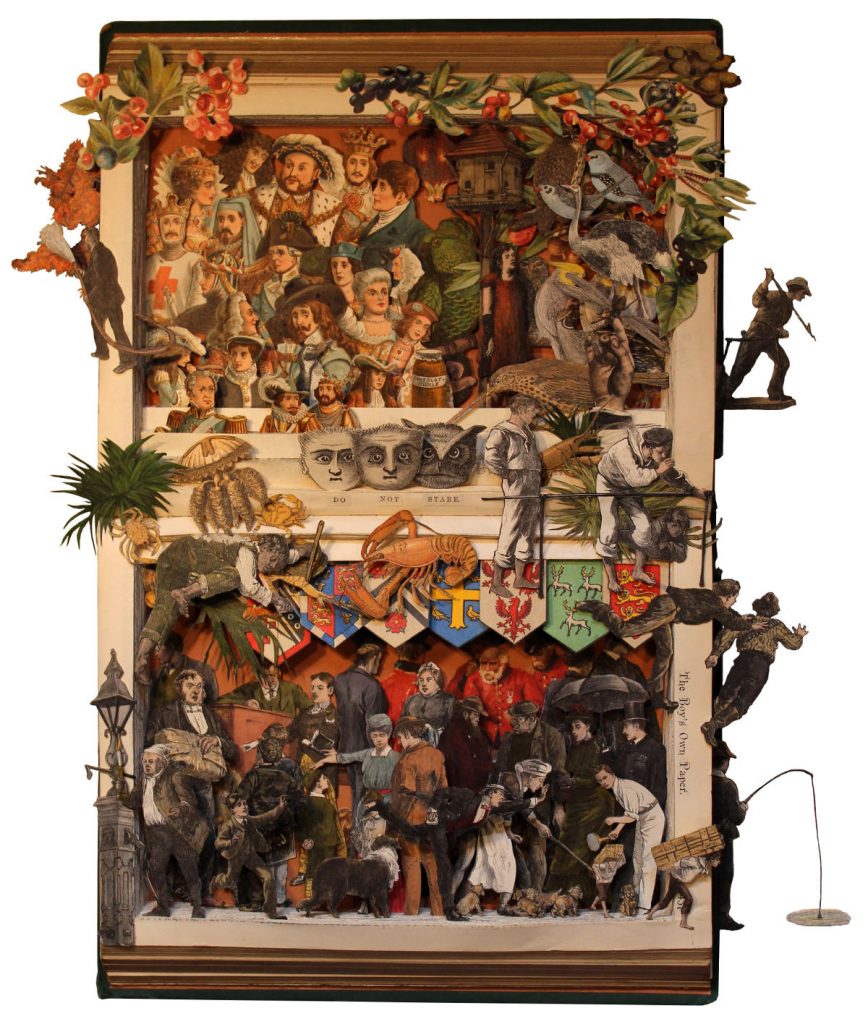
The Boy’s Own Annual, 1886, 465 x 395 x 38mm, Mixed Medium
Your work is just as delightful when the original cover is very worn – discuss (Mrs Beeton’s Book of Household Management)
I discovered this very old copy of “Mrs Beeton’s Book of Household Management” in a junk shop. Although complete, it was little more than a pile of loose pages, held together with an elastic band. Inside, however, the lovely illustrations were revealed to be in perfect condition. By restoring the book as far as possible, I was able to preserve its rugged and gnarled appearance, which I think greatly enhances the character of the sculpture. I make no apology for the missing spine and back cover.

Mrs Beeton’s Book of Household Management, 180 x 115 x 73mm, Mixed Medium
When is a book too rare for you to work with? How do you know?
I am keen to avoid using rare books in my work, but the price will usually reflect its rarity and I use this as a guide.
Comment on using catalogues.
I have only used one catalogue in my work so far. It was an 1890s catalogue of saddlery which relates to a London company that is still in existence.
In retrospect, my feeling is that catalogues lack sufficient character and interest.
Show us one or two books that have been very special to you and why.
It’s so hard to select just one or two books when they have all been special to me in different ways. I suppose I would single out the ones I particularly enjoyed creating.
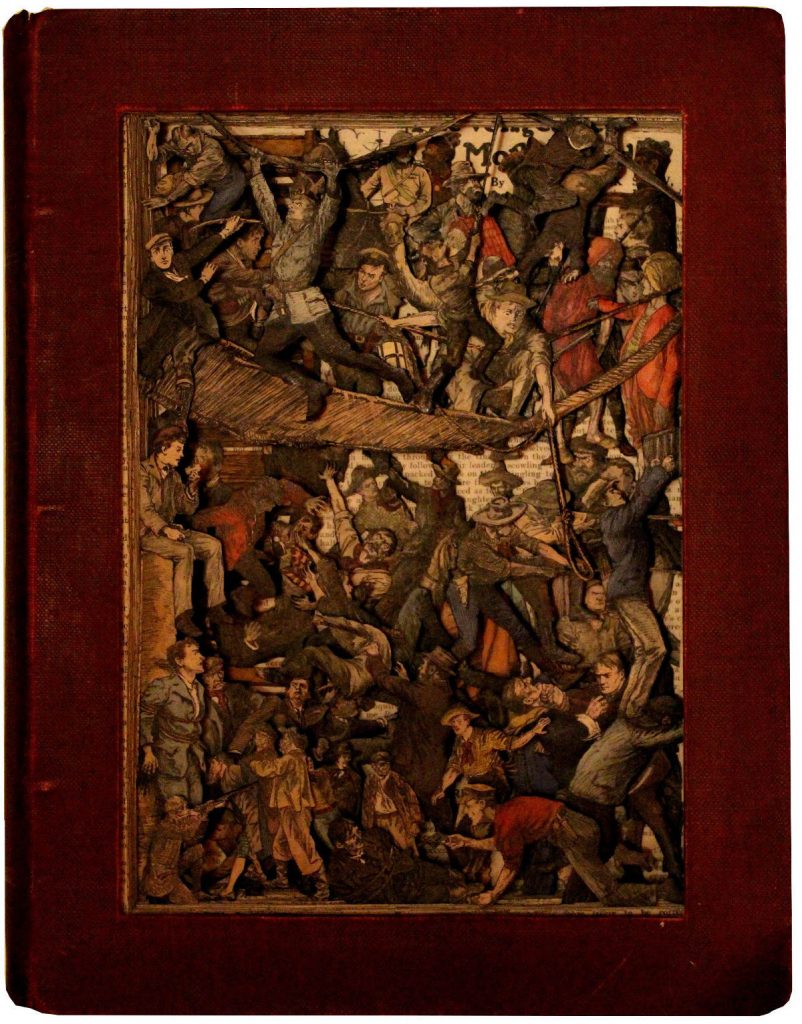
Chums, 308 x 240 x 62mm, Front, Mixed Medium
“Chums”, an annual from 1908/9 stands out in this respect, because of all the action that was portrayed, so much in fact that I made it into a double-sided piece.

Chums, 308 x 240 x 62mm, Front, Mixed Medium
Another one that springs to mind is “George Cruikshank’s Table Book”. This was tremendous fun to make because of the delightfully funny characters it contained – it made me smile just to work with them.

George Cruikshank’s Table Book, 250 x 82 x 30mm, Mixed Medium
Very briefly, explain how you cut and the tools you use.
Various different forms of cutting are required to make my book sculptures and to this end a number of different methods need to be employed. Apart from the more obvious scissors and scalpels with a large variety of different blades, my husband has put his engineering skills to good use and made me a set of tools which he has designed specifically for my work.
You exhibit around the world, how many exhibitions do you prepare for each year?
Each book sculpture takes a long time to make, so I am only able to produce a small number each year. For that reason, I have to keep the number of exhibitions to a manageable level.
Why do you think your work is so popular in America?
When I first started making my book sculptures, I was approached by a gallery in Los Angeles, who subsequently represented me for a number of years. When the principal of the gallery retired, I had the opportunity of being represented by the fabulous Heller Gallery in New York City, so now all the pieces I make are normally shipped directly to them.
But beyond that, I do think that Americans appear to be particularly drawn to the Englishness and also to the unique aspects of my work.
Deborah Blakeley, Melbourne, Australia
Interview by Deborah Blakeley, August, 2019
Think a colleague or friend could benefit from this interview?
Knowledge is one of the biggest assets in any business. So why not forward this on to your friends and colleagues so they too can start taking advantage of the insightful information the artist has given?
Other artists you may be interested in:


